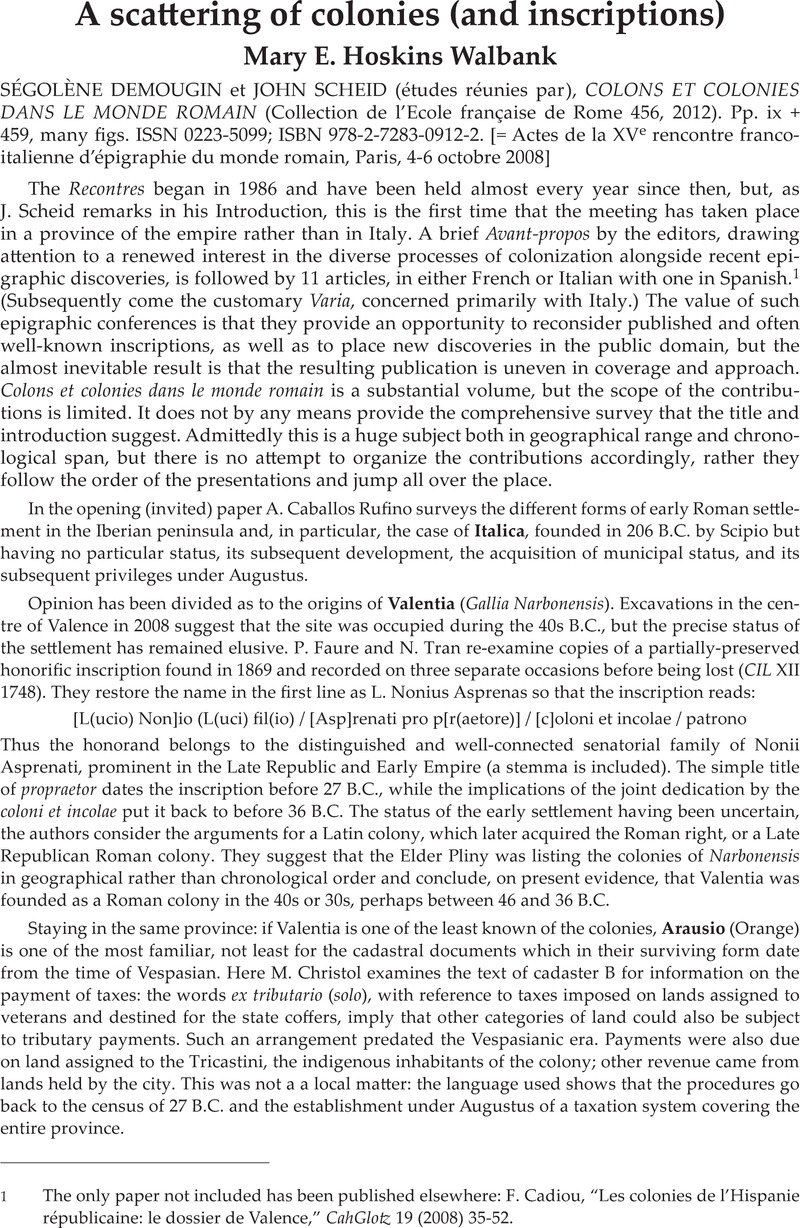Published online by Cambridge University Press: 27 November 2014

1 The only paper not included has been published elsewhere: Cadiou, F., “Les colonies de l’Hispanie républicaine: le dossier de Valence,” CahGlotz 19 (2008) 35–52 Google Scholar.
2 Perdrizet, P., “Voyage dans la Macédoine Première. (4). Le territoire de la colonia Augusta Iulia Philippi,” BCH 21 (1897) 536–43Google Scholar; Collart, P., Philippes, ville de Macédoine (Paris 1937)Google Scholar.
3 Papazoglu, F., “Le territoire de la colonie de Philippes,” BCH 106 (1982) 91–106 Google Scholar; ead., Les villes de Macédoine à l’époque romaine (Paris 1988) 409–10Google Scholar.
4 They will be published in collaboration with I. Sverkos.
5 LPGN vol. IIIA s.v. Τίγρις.
6 Laffi, U., Colonie e municipi nello stato romano (Rome 2007)Google Scholar.
7 Fragments found earlier are collected at Khanoussi, M. and Mastino, A., Uchi Maius 2 (Sassari 2006) no. 25Google Scholar.
8 Levick, B., Roman colonies in Asia Minor (Oxford 1984) especially 64 and 113–17Google Scholar.
9 Now attributed to Cassandreia, Dium or Dyme; there is no known coinage of Dyrrachium: RPC I, p. 289 Google Scholar. See also RPC I Suppl. 3 (2014) 30 Google Scholar.
10 Anamali, Sk., Ceka, H. and Deniaux, E., Corpus des inscriptions latines d'Albanie (CollEFR 410, 2009)Google Scholar.
11 Lolos, Y. A., “The Hadrianic aqueduct of Corinth,” Hesperia 66 (1997) 271–314 CrossRefGoogle Scholar.
12 Coleman, K. M., “Exchanging gladiators for an aqueduct at Aphrodisias (SEG 50. 1096),” Acta Class. 51 (2008) 31–46 Google Scholar.
13 Milestone erected in 124 and renewed under Constantine I: see Daux, G., “Le milliaire de la via Egnatia au Musée du Louvre,” JSav 1977, 145–63Google Scholar (not 1997 as stated by Deniaux).
14 Walbank, F. W., “The via Egnatia: its role in Roman strategy,” RivTopAnt 12 (2003) especially 16–17 Google Scholar.
15 See infra n.21.
16 The page reference to the reprint of Mann's 1965 article should be 127, not 124.
17 Hurst, H. (ed.), The coloniae of Roman Britain: new studies and a review (JRA Suppl. 36, 1999)Google Scholar.
18 R. Reece, “Colonia in context: Glevum and the civitas Dobunnorum,” ibid. 73-85.
19 E.g., S. Roskams, “The hinterlands of York, present patterns and future strategies,” ibid. 45-72. For London, see Bird, D. G., “The London region in the Roman period,” in Bird, J., Hassall, M. and Sheldon, H. (edd.), Interpreting Roman London. Papers in memory of Hugh Chapman (Oxford 1996) 217–32Google Scholar.
20 On the debate, see Tomlin, R. S. O., “Was Roman London ever a colonia? The written evidence,” in Wilson, R. J. A. (ed.), ROMANITAS: essays on Roman archaeology in honour of Sheppard Frere on the occasion of his ninetieth birthday (Oxford 2006)Google Scholar; also the review of RIB III by Birley, A. R., at JRA 24 (2011) 682–83Google Scholar.
21 RIB III, 3006 Google Scholar. Discussion and photographs: S. Corcoran, B. Salway and P. Salway, “Moritix Londiniensium: a recent epigraphic find,” also available at www.britishepigraphysociety.org=Newsletter n.s. 8 (2002) 10-13. I have not seen Dondin-Payre, M. et Loriot, X., “Tiberinius Celerianus à Londres: Bellovaque et ‘moritix’,” AntCl 77 (2008) 127–69Google Scholar.
22 Haensch, R., Capita provinciarum (Mainz 1997)Google Scholar.
23 Caldelli, M. L., Gregori, G. L. and Orlandi, S. (edd.), Epigrafia 2006. Atti della XIV Rencontre sur l’épigraphie in onore di Silvio Panciera … (3 vols., Tituli 9, 2008)Google Scholar.